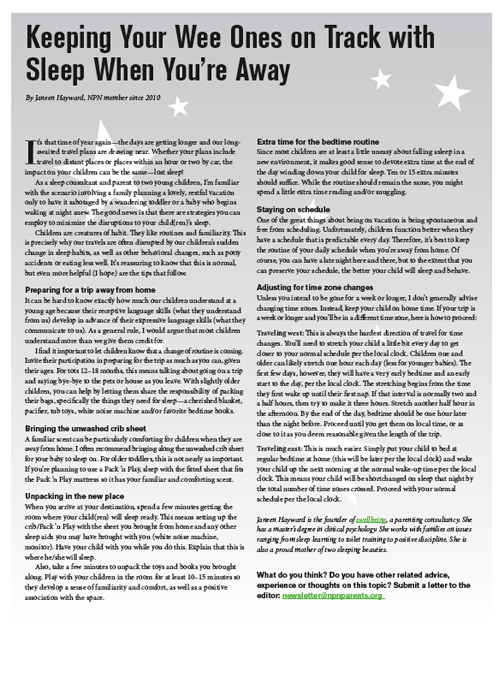

It’s that time of year again—the days are getting longer and our long awaited travel plans are drawing near. Whether your plans include travel to distant places or places within an hour or two by car, the impact on your children can be the same—lost sleep! As a sleep consultant and parent to two young children, I’m familiar with the scenario involving a family planning a lovely, restful vacation only to have it sabotaged by a wandering toddler or a baby who begins waking at night anew. The good news is that there are strategies you can employ to minimize the disruptions to your child(ren)’s sleep. Children are creatures of habit. They like routines and familiarity. This is precisely why our travels are often disrupted by our children’s sudden change in sleep habits, as well as other behavioral changes, such as potty accidents or eating less well. It’s reassuring to know that this is normal, but even more helpful (I hope) are the tips that follow.
Preparing for a trip away from home
It can be hard to know exactly how much our children understand at a young age because their receptive language skills (what they understand from us) develop in advance of their expressive language skills (what they communicate to us). As a general rule, I would argue that most children understand more than we give them credit for.
I find it important to let children know that a change of routine is coming. Invite their participation in preparing for the trip as much as you can, given their ages. For tots 12–18 months, this means talking about going on a trip and saying bye-bye to the pets or house as you leave. With slightly older children, you can help by letting them share the responsibility of packing their bags, specifically the things they need for sleep—a cherished blanket, pacifier, tub toys, white noise machine and/or favorite bedtime books.
Bringing the unwashed crib sheet
A familiar scent can be particularly comforting for children when they are away from home. I often recommend bringing along the unwashed crib sheet for your baby to sleep on. For older toddlers, this is not nearly as important. If you’re planning to use a Pack ’n Play, sleep with the fitted sheet that fits the Pack ’n Play mattress so it has your familiar and comforting scent.
Unpacking in the new place
When you arrive at your destination, spend a few minutes getting the room where your child(ren) will sleep ready. This means setting up the crib/Pack ’n Play with the sheet you brought from home and any other sleep aids you may have brought with you (white noise machine, monitor). Have your child with you while you do this. Explain that this is where he/she will sleep.
Also, take a few minutes to unpack the toys and books you brought along. Play with your children in the room for at least 10–15 minutes so they develop a sense of familiarity and comfort, as well as a positive association with the space.
Extra time for the bedtime routine
Since most children are at least a little uneasy about falling asleep in a new environment, it makes good sense to devote extra time at the end of the day winding down your child for sleep. Ten or 15 extra minutes should suffice. While the routine should remain the same, you might spend a little extra time reading and/or snuggling.
Staying on schedule
One of the great things about being on vacation is being spontaneous and free from scheduling. Unfortunately, children function better when they have a schedule that is predictable every day.Therefore, it’s best to keep the routine of your daily schedule when you’re away from home. Of course, you can have a late night here and there, but to the extent that you can preserve your schedule, the better your child will sleep and behave.
Adjusting for time zone changes
Unless you intend to be gone for a week or longer, I don’t generally advise changing time zones. Instead, keep your child on home time. If your trip is a week or longer and you’ll be in a different time zone, here is how to proceed:
Traveling west: This is always the hardest direction of travel for time changes. You’ll need to stretch your child a little bit every day to get closer to your normal schedule per the local clock. Children one and older can likely stretch one hour each day (less for younger babies).The first few days, however, they will have a very early bedtime and an early start to the day, per the local clock.The stretching begins from the time they first wake up until their first nap. If that interval is normally two and a half hours, then try to make it three hours. Stretch another half hour in the afternoon. By the end of the day, bedtime should be one hour later than the night before. Proceed until you get them on local time, or as close to it as you deem reasonable given the length of the trip.
Traveling east: This is much easier. Simply put your child to bed at regular bedtime at home (this will be later per the local clock) and wake your child up the next morning at the normal wake-up time per the local clock.This means your child will be shortchanged on sleep that night by the total number of time zones crossed. Proceed with your normal schedule per the local clock.
